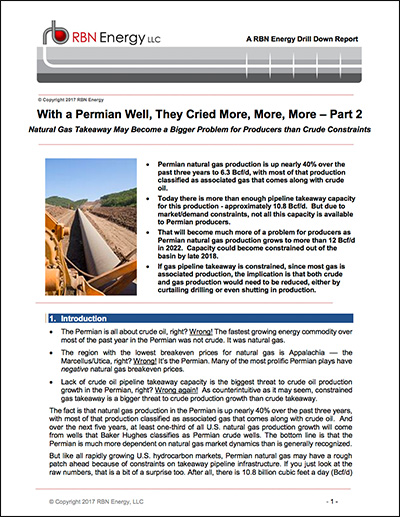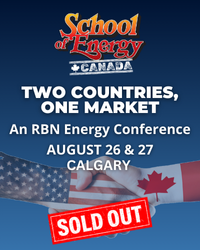Drilling, well completions and multibillion-dollar investments in the Permian are being driven by the region’s potential for producing vast quantities of crude oil. But the Permian juggernaut isn’t only about crude — far from it. Over most of the past 12 months, the fastest-growing energy commodity in the Permian wasn’t crude oil, it was natural gas. And consider this: The U.S. play with the lowest breakeven prices for natural gas is not the Marcellus/Utica. It’s the Permian, where many of the most prolific areas have negative natural gas breakeven prices. And perhaps most important, constrained gas takeaway capacity poses a bigger threat to Permian crude production growth than constrained crude takeaway capacity, because if the gas produced in the play can’t be transported to market, crude production may need to be curtailed. Today we discuss highlights from RBN’s new Drill Down Report, which focuses on the all-important gas side of the U.S.’s hottest hydrocarbon production region.
It’s easy — and perfectly understandable — to focus on the crude oil side of the Permian story. As we said in Part 1 of our Drill Down Report series on the Permian, With a Permian Well, They Cried More, More, More - Part 1, for the past two years the super-hot play has been the engine propelling U.S. crude oil production upward. The 70,000-square-mile Permian region in West Texas and southeastern New Mexico has the most favorable production economics of any U.S. play, and half of all the rigs drilling for crude in the U.S. are doing so within the Permian. Crude production there now tops 2.3 million barrels per day (MMb/d), or about one-quarter of total production in the Lower 48.
NEW Backstage Pass Drill Down Report
With a Permian Well, They Cried More, More, More – Part 2: Natural Gas Takeaway May Become a Bigger Problem for Producers than Crude Constraints
Natural gas production in the Permian is up nearly 40% over the past three years, with most of that production classified as associated gas that comes along with crude oil. And over the next five years, at least one-third of all U.S. natural gas production growth will come from wells that Baker Hughes classifies as Permian crude wells. The bottom line is that the Permian is much more dependent on natural gas market dynamics than is generally recognized. But like all rapidly growing U.S. hydrocarbon markets, Permian natural gas may have a rough patch ahead, due to constraints on takeaway pipeline infrastructure. This RBN Drill Down Report is the second in a series of Permian assessments, this time focusing on the natural gas market.
Click Here for More Information on Part 2 of our Permian Drill Down Report Series
Don’t forget, though, that natural gas production in the Permian is up nearly 40% over the past three years, with most of that production classified as associated gas that comes up the drill pipe with crude oil. And over the next five years, at least one-third of all U.S. natural gas production growth will come from wells that Baker Hughes classifies as Permian crude wells. The bottom line is that the Permian is much more dependent on natural gas market dynamics than is generally recognized.
Join Backstage Pass to Read Full Article







